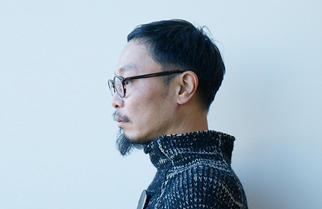

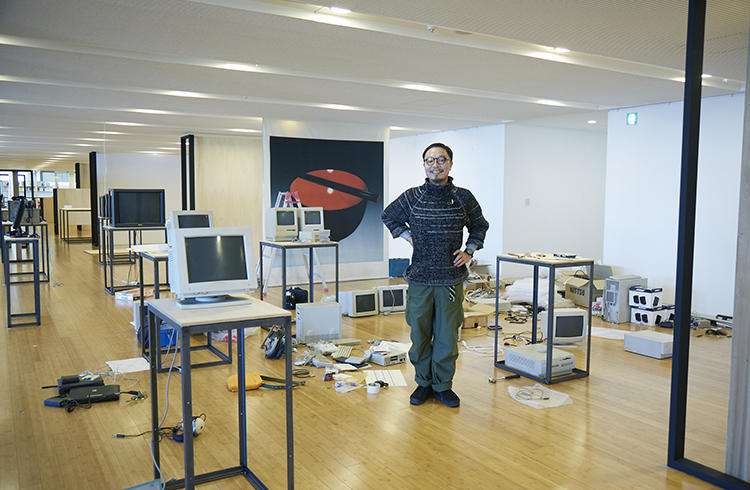
“The ideal future - feeling energized in everyday life”
Holding Roppongi Future Talks in Shibuya and Aoyama Self-service stalls fromver Japan
Shigeki Hattori is president of graf, a company which undertakes architectural and interior design, branding strategies, and neighborhood revitalization projects. At the Tokyo Midtown DESIGN TOUCH in 2014, Hattori taught a class on design philosophy at the School in the Forest. In this interview, Hattori talked about Roppongi, the future and everyday life.
Design and art that make people use their five senses
The word "seikatsu" (life) is comprised of the kanji characters "sei" which means to live, and "katsu" which means energy. You need energy in order to live. That has been on my mind lately, particularly because I'd spent time in a hospital. It occurred to me that just as with everything else, technology and medical treatment should be designed to give energy to people. In a hospital for example, it's difficult to think about one's future because the focus is on treating an illness. Hospitals are so functional; they have not been built to let the patients have hopes for their future.
In the past, the culture and the economy and everything were all linked to everyday life, and that gave people the energy to live. But in the 20th century, those aspects were cut off from people's lives; too much importance was placed on functionality and efficiency. We need to properly restore and reorganize the everyday life. To do that, the things that used to exist should be recovered and I believe that design and art can help us.
Design and art can let us make full use of our five senses which is vital for energizing ourselves. When we use our five senses - when we look at things and touch things and taste things - our awareness is sharpened and we come up with ideas. We become motivated and more willing to make slight improvements. When we are given the opportunity to be resourceful, we become filled with energy. It used to be like that in the past and I believe that is how our lives should be like.
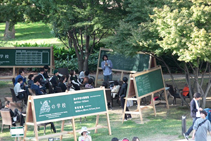
School in the Forest
The School in the Forest was a series of open-air classes held during the Tokyo Midtown DESIGN TOUCH event. A creator had proposed setting up a school during the "Roppongi Future Talks" interview. It was the fourth time that an idea given by an interviewee had been given shape. Hattori taught a class on traditional crafts and presided over discussions held between class participants. The blackboard and bookshelves shown in the photograph were designed by graf.
Returning to our roots and rethinking how we live
The first step to getting the energy to live is to have the ability to use tools. Our grandpas and grandmas knew how to use a single tool in many different ways. They were resourceful in their everyday lives. Today, when we want to cook pasta, we think we need to first buy a pasta pot, but any old pot would be fine - as long as we have water to boil the pasta in.
Not realizing that we don't need special gadgets illustrates how numb we have become. We've become incapable of coming up with ideas because the tools we use in our daily lives have become so specialized and have such specific functions. So we've fallen back, but I think now is the time to return to the basics and rebuild our everyday lives.
In the areas of technology and science too, there will probably be increasing demand in the future for things that appeal to the five senses. Technology and science are highly specialized areas and are difficult to understand, but the power of design can help us overcome those obstacles. Design should be used to translate things for the layman.
Ideas born from "inconvenient" technology
How can we make it easier for people to come up with ideas? The answer is simple. We just need to make things inconvenient. The digital age has brought us convenience, but if digital things were not so easy to use, we would become better at using them, and we would probably come up with new ideas. Technology makes things easier for us, but I think it's time to reverse the trend and make things less handy.
Did you know that there is something called virtual food? You can control your calorie intake by wearing special glasses that make a plain cookie look like a chocolate cookie. When you wear the glasses, the visual information tells you that you are eating a rich chocolate cookie even though your body is actually digesting a plain cookie. You have to go through the trouble of wearing cumbersome glasses in order to fool your mind. It's not a convenient gadget, but it's this kind of "inconvenient" technology that I feel will lead to new ideas.
The virtual food is about using technology to deceive your brain for the benefit of your body. I think this sort of thing can be done not only digitally, but also in an analog way. For example, we could make switches that look as if they are for turning on the electricity, but when pushed, trigger something unexpected. All kinds of devices could be made that deceive the brain and the body. Roppongi is known as a cutting-edge place, so it would be fun if we could show such devices here under the catchphrase, "You are being taken in!"

A place that changes dramatically according to the hour of day
I've always been based in Osaka, but on my visits to Tokyo, I often went to Ristorante da Nino which is located beyond Tokyo Midtown. I would go there with my girlfriend whom I thought I would marry. (laughs) Once, when I was smoking a cigarette in front of the restaurant, I met the art director and actor Michio Akiyama-san. He said, "Hattori, you are smoking too fast. Cigarettes are meant to give color to the atmosphere. Smoking like that makes you look like a restless guy. It's uncool." He told me that I should pay attention to inhaling time. I thought, Wow, that's so cool. And it made me want to keep smoking all my life. I just remembered that moment so vividly. (laughs)
Ristorante da Nino
An Italian restaurant located near Nogizaka station, a little distance from Gaien Higashi Dori. The chef-owner Antonino Lentini is known as the "Ambassador of Authentic Traditional Sicilian Cuisine". In the colorfully decorated restaurant, one can enjoy fresh seafood and choose from more than 200 different types of Sicilian wine.
I wasn't very impressed with Roppongi just after Roppongi Hills was completed, but I think the place has become very nice recently. At Tokyo Midtown, there's the lawn and the woods behind the high-rise buildings, and the atmosphere changes so dramatically during the weekends compared to the weekdays. It's interesting how the same place offers different functions and lifestyles for people, and how daily life can change so much according to the hour of day.
At Tokyo Midtown the other day, I participated in Dainippon-ichi Expo which was an event to celebrate the 300th anniversary of Nakagawa Masashichi Shoten. Nakagawa Masashichi Shoten is a brand that was jointly set up by Manabu Mizuno-kun, Jun Nakagawa-kun and myself and I've always been involved with it. The concept of the brand is to make tools for "kurashi" (living). But the term "kurashi" is used so much these days and I prefer the word "seikatsu" (life ).
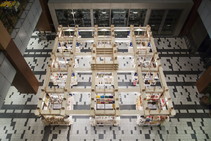
Dainippon-ichi Expo
A handcraft fair held by Nakagawa Masashichi Shoten - a manufacturer and retailer of household goods - in collaboration with traditional artisans from across Japan. The fair, featuring talk shows and workshops, was first held in January 2016 at Tokyo Midtown and will be held in four other cities in Japan. The venue design was undertaken by graf.
Making Roppongi Hills and Tokyo Midtown appealing for the older generation
It recently struck me that the Japanese language is fascinating - almost anything can be expressed with two kanji characters. People often talk about how brands are about stories, don't they? The word "story" is comprised of the kanji characters for "talk" and "things." A story needs to be told about the things being made in order to establish a brand. In Japan, people make things of good quality but they don't talk enough about them, and that's why brands don't get established. There's excellent craftsmanship, so all we have to do is to tell people about the manufacturing process. There's such a lot to talk about.
The meaning of the kanji characters for "seikatsu" may not have much significance for young people, but the grandpas and grandmas of Japan who helped make this country, are now really in need of the energy to live. We should think about what we can do for them. With the smart phone for example, we should think about what kind of functions and technology would be useful. We need to do a lot more than just making larger fonts.
Roppongi has the potential of becoming a place that creates the energy to live. It's a place of design and art, and if people were to live here, they would need to make use of all their senses and find the energy to live. Maybe if people became really good at doing that, the grandpas who come to Roppongi Hills or Midtown will be cured of their dementia and they might suddenly have romantic feelings toward their wives again. Of course, towns should be made for the young people but I feel that Roppongi will become a brighter place if it resonated with the grandmas and grandpas.
The appeal of cities which have close communities
A city I'm drawn to is Kagoshima. There's a very well-balanced age structure in the population, and its streets are nicely built. People have a traditional system of helping each other through groups called "yui" or "ko". The older people willingly give support to the young people. For example, if a twenty-something person gets an interesting idea for a project and asks for help, the elders will cooperate in matters such as getting financing, and the local authorities will also lend a hand. There's a system within the community to let the young do what they want to do - and it doesn't have to be an artistic project.
Shinichiro Nakahara-kun of Landscape Products is from Kagoshima and he is always so generous to me. He lets me borrow his car which is parked at the airport and I drive to Kagoshima City to stay at his guest house. Even when Nakahara-kun himself is not there, I get visits from all kinds of people. They tell me which restaurants to go to and when I go out to drink, I meet and bond with more people, and we go drinking at yet another establishment. (laughs) Aside from the buildings and infrastructure, it's the community - the network of people that makes a town appealing.
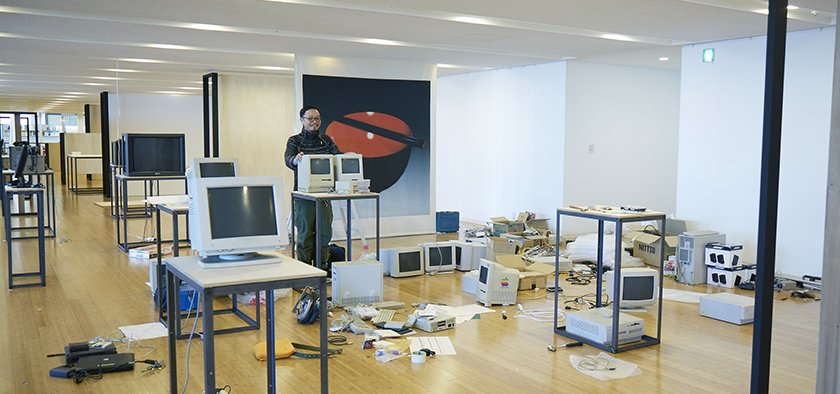
Growing up near an awe-inspiring museum
Until last year, I'd been doing a lot of work on projects in other regions. I feel I've had enough of that for now, and this year, I intend to return to my hometown and focus on making things. I was born in the year that the Expo '70 was held in Osaka. The place I was born is near the Expo '70 Commemorative Park. Of course I don't remember anything about the expo and by the time I was able to notice things, all I saw of the expo were its remains. I grew up looking at the futurist remnants of that expo.
But many of the remnants were wonderful. For example, there was the Minpaku (National Museum of Ethnology) which I visited almost every day. That is a facility you should definitely go to! The musician UA said she went to Minapaku when she was at elementary school and was so thrilled that she almost wet herself. There are a lot of creators who lived near the expo site - Shigeo Goto-san, Kenji Yanobe-san, Kohei Nawa-kun, Uma Harada-kun are among them. Perhaps the region had a unique education policy, but I'm sure that we were influenced [by the Minpaku].
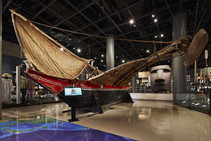
National Museum of Ethnology (Minpaku)
A museum and research institute that conducts studies on anthropology and ethnology and collects and displays artifacts and materials on cultures around the world. It opened in 1977 and is located in Expo'70 Commemorative Park in Osaka's Suita City. The museum has regional displays where artifacts are categorized into nine regional groups, as well as displays on folk music and languages. Special exhibitions are held several times a year. The museum building was designed by sho Kurokawa.
The museum is filled with information about all the ethnic groups on earth. You can learn about the customs that have been carried on since the primitive age, the colors that were used, how medicinal herbs were blended, and about the types of dances and tools they had - all the data is there. It's the history of the human race and it's like looking at the world. You would be surprised. It's not about a span of 2,000-3,000 years - it goes way, way back.
Taking the long-term perspective when making things
We need to look at things from a long-term perspective and think ahead 100 years or more. Having traveled to many different regions, I've found out that the oldest history people can talk about concerning traditional crafts or a certain industry is three generations ago - they know only about what happened in the last century or so. Maybe that's inevitable, but if we could trace our roots back to around 1,000 years ago, we would easily get ideas for souvenirs and for ways to revive industries.
I'm currently involved in a project to revitalize a "new town" in Osaka. We're pulling it part and trying to reinvent the town, setting up the necessary facilities. When "new towns" were built, people were thinking only about 50 years ahead, and inevitably the facilities are now deteriorating. We need to build things with a much longer time span in mind. I find the work fun.
I talked earlier about inconvenient tools. I feel that humans have regressed from possessing too many convenient things. That's why I think we need to create items that will make people more resourceful. In 2011, graf started making a series of tools aimed at encouraging creativity. This year, we are looking upgrade it. By making things that are less convenient, we hope to give people the opportunity to become more aware of what they can do for themselves in all areas of everyday life.
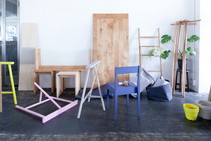
TROPE
An innovative brand of mostly "unfinished" furniture and household utensils designed by graf. Consisting of items such as boards desk legs, chairs, hooks, ladders and paint which have no specified use, they are meant to prompt the user to think of different ways of using them.
Self-service stalls in Roppongi
I'm glad to hear that people liked the blackboard and bookshelves we made for School in the Forest. Perhaps it might be a good idea to make them portable and take them outside of Roppongi. You could do a tour, holding Roppongi Future Talks in Shibuya or Aoyama. The blackboard and bookshelves could be used at events where people learn about Roppongi's vision of the future. You could take the blackboard and bookshelves to all sorts of places and promote Roppongi's futuristic philosophy.
And how about setting up self-service stalls? I'm doing a project with students now to study the self-service farmers' stalls in the countryside. Despite being unmanned, none of the money and the goods is stolen. The exchange of money and goods is properly carried out, and there is an invisible bond of trust between vendor and customer. If Roppongi is an area of good people, then no problems should arise with self-service stalls. Let's set the stalls up as an experiment!
Perhaps we could sell things like pictures drawn by the grandpas in Roppongi, or perhaps homegrown produce, or handcraft made by housewives. It would probably be best for the goods to be exchanged for money, but hopefully, the stall would bring warmth to people's hearts. Maybe we could hold a fair, gathering all the self-service stalls in Japan from Hokkaido to Okinawa. We could have discussions on what people should give in exchange for the goods. Pondering those things is what the process of design is about. You find the idea interesting? Great! I hope you will think about it. (laughs)
Editor's thoughts
The main photos for this article were taken at Tokyo Midtown Design Hub where preparations were being made for the "Digital Media and Japanese Graphic Design- Its Past and Future" exhibition (held until Feb.14 2016) Looking musingly at an old Mac computer, Hattori-san said, "I bought this for about 700,000 yen and then launched graf. It brings back memories. It's thanks to computers like this that life has become convenient, but [the convenience] is also a trap that we have fallen into, and we need to climb out of it." http://designhub.jp/exhibitions/1891/
(edit_kentaro inoue)




